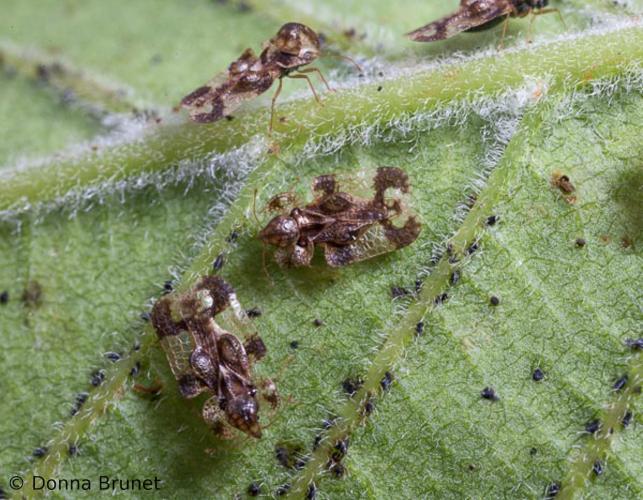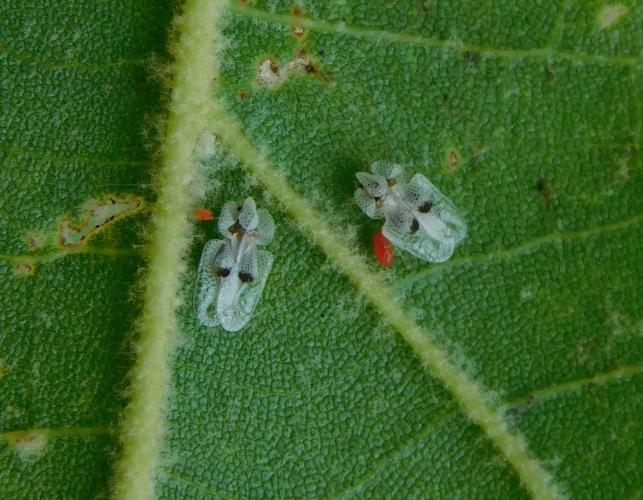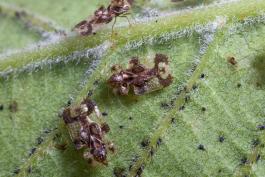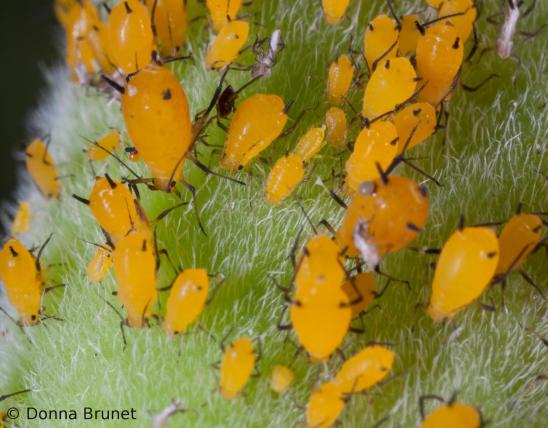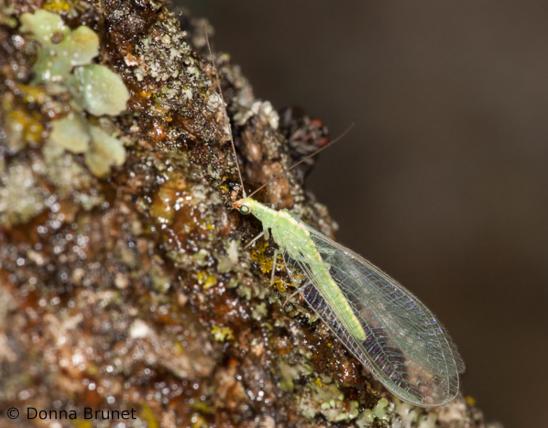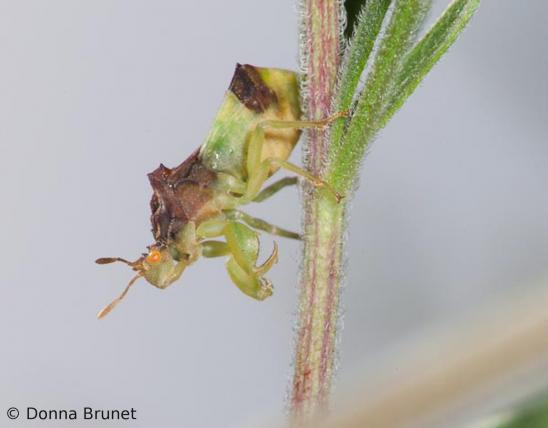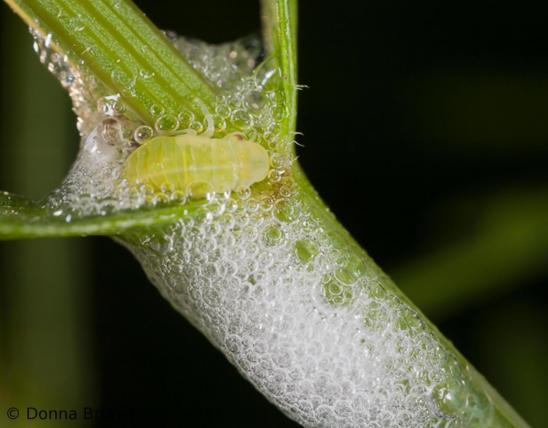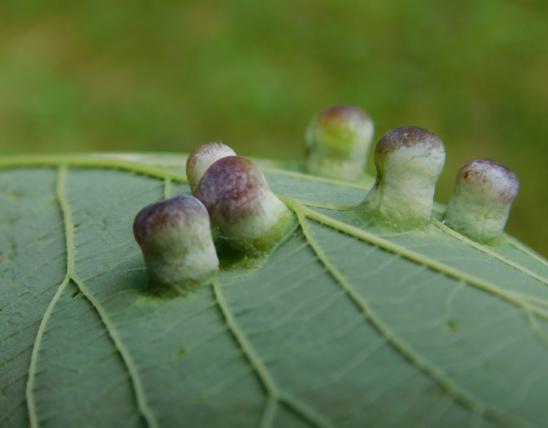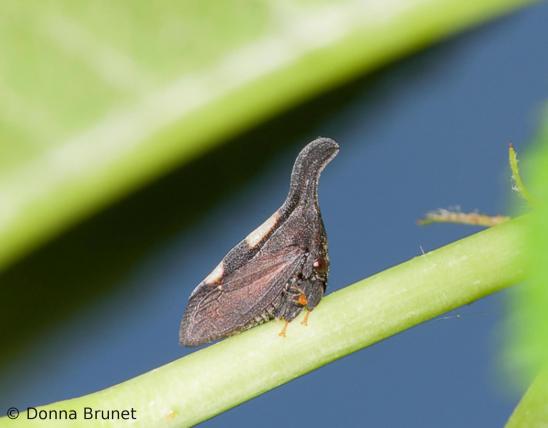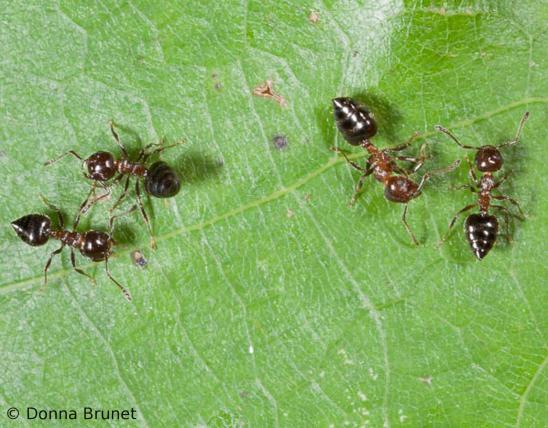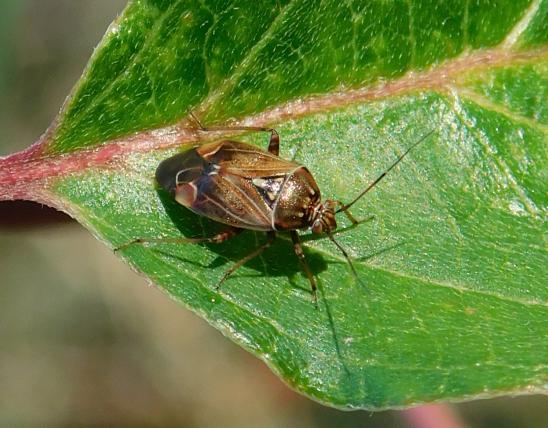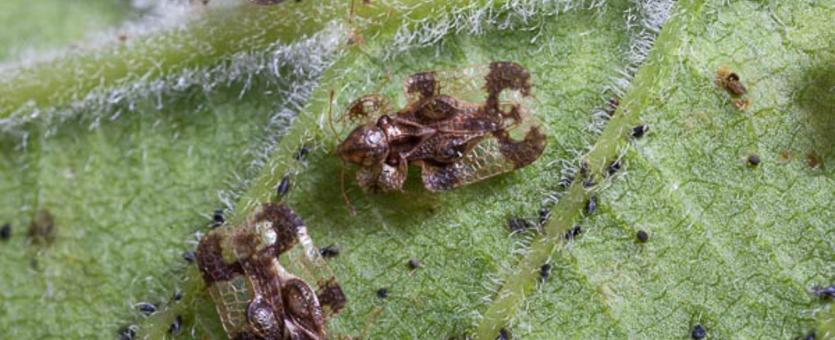
Small, flattened, and usually broadly rectangular, lace bugs have a lacy network of ridges on the forewings and body. The large, shoulderlike pronotum extends backward in a triangle and forward to cover the head. They are usually gray or whitish, with dark markings. Some species are narrow-bodied, and some species are brown or dark-colored. Nymphs are usually blackish and spiny.
Some common Missouri lace bugs include:
- The sycamore lace bug (Corythucha ciliata) is very common on sycamore trees. Turn the leaves over, and often you can see adult lace bugs plus their nymphs, eggs, empty shed skins, and peppery black poop pellets. Large infestations in late summer can cause a sycamore tree to drop its leaves before autumn. A native North American insect, it was imported to Europe and now occurs on the sycamores that line the boulevards on that continent.
- Many other species of Corythucha are named for their host plants: oak lace bug, elm lace bug, buckeye lace bug, cherry lace bug, hackberry lace bug, hawthorn lace bug . . . you get the idea! Because so many species of lace bugs are limited to a certain type of food plant, identifying the plant they’re eating can help identify the bug.
- The eggplant lace bug (Gargaphia solani) is a pest on a wide variety of plants in the nightshade family, including eggplant, potato, tomato, and horsenettle, but also cotton (in the mallow family), sunflower (in the sunflower family), and sage (in the mint family).
Length: less than ¼ inch (usually about 3–5 mm).
Statewide. Different species may have different distributions, according to the distributions of their required food plants.
Habitat and Conservation
Lace bugs are slow-moving insects that usually feed on the undersides of leaves, causing pale or brown spots on the leaves. These spots might be the first sign of their presence. When lace bugs occur in numbers (as they often do), their tiny black excrement pellets may also be noticeable on leaves. Observers have noted that many species seem to prefer hot, sunny areas.
Food
With their tubelike beaks, lace bugs pierce foliage and suck sap and nutrients from plants (usually, it’s trees and other woody plants, but some species use nonwoody plants). Lace bugs usually feed on the undersides of leaves, and most species are host specific — they are limited to certain kinds of food plants and cannot survive on any others.
Life Cycle
Like other true bugs, metamorphosis is simple, with no grub or caterpillar stage and no pupation. Instead, the nymph stages between egg and winged adult look more or less like smaller, wingless versions of the adult. Most lace bugs nymphs are black and spiny. Adults overwinter in protected places, such as crannies under bark or amid fallen leaves or other detritus on the ground.
Some species of lace bugs exhibit maternal care, with females tending eggs (which they attach to the underside of food plant leaves, usually near veins) and nymphs. Female eggplant lace bugs sometimes deposit their eggs among those of other female eggplant lace bugs — this rather sneaky behavior allows the “egg-dumping” mothers to spend more time and energy creating additional eggs, while the duped mothers invest time and energy protecting not only their own young but also those of the “dumper” females.
Human Connections
When they occur in large numbers, lace bugs can be destructive pests, capable of defoliating trees. Pesticides are often ineffective, since the large size of trees can make spraying impractical, and adults can take shelter under bark, under leaves, and elsewhere.
There is plenty of information online for dealing with lace bug infestations. Generally, do what you can to keep your landscaping plants healthy in the first place. Also, encourage the presence of predators such as lady beetles, lacewing larvae, jumping spiders, assassin bugs, and wrens, warblers, and other insect-eating birds. Finally, if your tree lost leaves due to lace bugs, rake the leaf litter away from the tree base and dispose of it, since it likely harbors eggs and/or overwintering insects.
Although pesticide options exist, try to tolerate lace bugs in your landscape. These inglorious insects feed a wide variety of wildlife that people consider beneficial, and collectively they have an important role in nature. Plus, the damage lace bugs do — even though it’s not attractive — is usually not serious.
It’s common for lace bugs to fall onto people when we stand under the trees they’re feeding on. It’s possible that a lace bug might poke you with its beak, but it’s a harmless annoyance. Lace bugs are harmless to people.
Ecosystem Connections
Although a heavy infestation of lace bugs can cause early leaf drop in trees, have faith in the tree’s ability to rebound. Leaf drop is the tree’s way of getting rid of its parasites. A single year of this should not harm a tree, but if severe infestations repeat in consecutive years, or if they are combined with other stressors (such as drought, flooding, or disease), the tree might die.
Many insects and other small, creepy predators consume lace bugs, including assassin bugs, lacewing larvae, parasitic wasps, jumping spiders, lady bird larvae, and more — a reminder to tolerate our fellow earthlings.
One reason why many birds spend a lot of time in trees is because they are hunting the many, many kinds of insects and spiders that live in trees.
Insects whose diet is limited to certain types of plants are intimately connected to those plants and the habitats they occur in. The birds and other predators that rely on those insects for food therefore rely on the plants. Just as a computer relies of each byte of information it holds, all components of natural communities are important.
